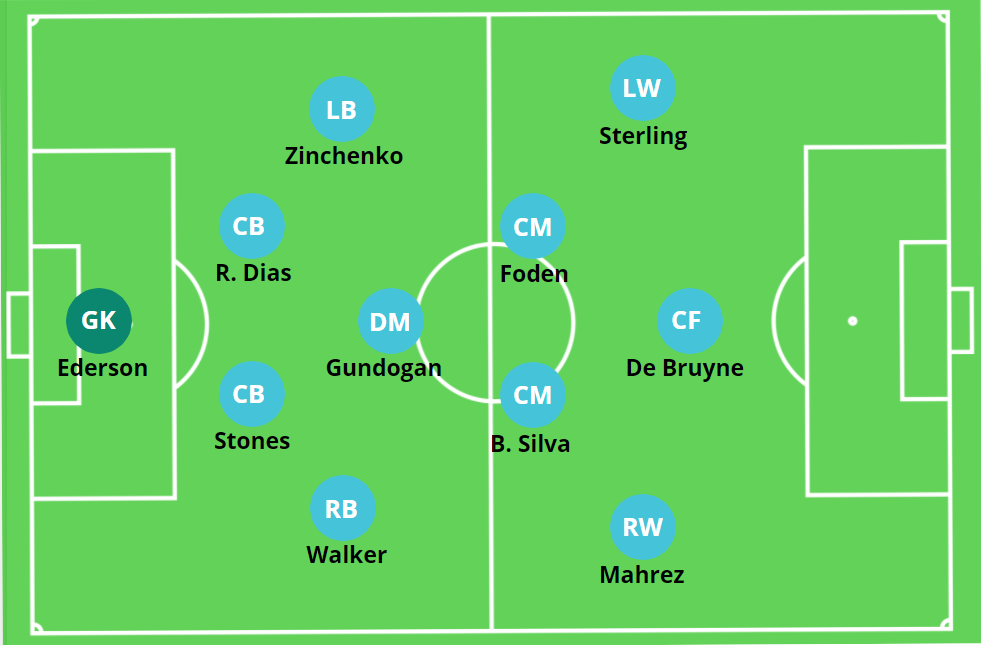What a game. After beating Manchester City twice already this season, Chelsea entered the 2021 UEFA Champions League final with a slight psychological advantage. They absolutely delivered on that promise, winning the match by a score of 1-0. Thomas Tuchel became only the second manager since Jurgen Klopp to beat Pep Guardiola three times in a row, leading his Chelsea team to the Champions League trophy in his first six months in charge. Here is our tactical analysis of the final.
manchester city – 4-3-3

Manchester City set up a 4-3-3 formation, filled with positional rotation and fluid movement of almost all players involved. Kevin de Bruyne operated as the false nine in the team, but Phil Foden played practically right on top of him, giving the shape a very 4-2-3-1 or 4-2-4 look at times instead. But due to Bernardo Silva’s high and wide position himself, the 4-3-3 shape was likely Guardiola’s intent. The most notable omission from the team was in neglecting to play either Rodri or Fernandinho, instead utilizing goal-scoring Gundogan as the number six.
IN POSSESSION
Embed from Getty ImagesPep Guardiola’s team kept 60% of the ball in the match, forcing Chelsea to adopt a much different, counter-attacking style in response. The Sky Blues played out from the back through vertical channels. They used Oleksandr Zinchenko as an inverted fullback high on the left side, looking to exploit space in between Havertz and Kante. Bernardo Silva also played high and wide as already noted, sometimes drifting so wide that Mahrez moved in-field instead. Foden’s movement was also very fluid, and his most common position was that of a number ten, searching for space in between the gaps of Kante and Jorginho. Their attacking shape often resembled a 2-4-4, with Foden clearly higher than Bernardo, and fullbacks looking to get themselves involved but struggling to do so.

Guardiola’s men created several good shooting opportunities through energetic running in wide areas, but had nobody to finish them off. They were quite deadly in the final third in playing wide to the likes of Mahrez, de Bruyne and Sterling to complete passes into the penalty area, driven across the grass. But Chelsea’s five man defense meant that they had several numbers in the box to cut these passes out. In this regard, City’s lack of a natural number nine could be considered to be a miss. But more likely, Chelsea’s defense were just that good and that well positioned to cut off their attacks. In fact, after he arrived, Sergio Aguero barely touched the ball.
A final note on the fluid movement of all Manchester City attackers is that it most likely just confused their own ability to progress in the final third more than anything. Bernardo found himself on top of Mahrez at times, limiting the Algerian’s involvement. Meanwhile, de Bruyne could hardly find pockets of space to pick up the ball, as Bernardo and Foden roamed around instead and stole some of his opportunities away.
out of possession
Embed from Getty ImagesManchester City attempted to transition from attack to defense quickly, looking to match Chelsea’s speed on the break pace for pace. Sometimes they were effective in doing so, and other times the Blues almost took advantage. For the most part however, City dealt with Chelsea’s counter attacks well and forced them to slow down the tempo, go backwards and start again.

City pressed in a 4-2-4 shape, with Foden and De Bruyne combining on both sides of the field along with near-sided winger and the near-sided central midfielder (Gundogan or Bernardo). As N’Golo Kante galloped up the field, Ilkay Gundogan was the man tasked with tracking his movement. Perhaps Gundogan’s positional sense in the defensive third let him down more than Rodri or Fernandinho might have been able to accomplish, but this is difficult to say. His reserved, more defensive role did however stunt his ability to go on the hunt and attack, which was a greater miss for the Sky Blues than they would have thought by putting him in that position.
On the goal, John Stones found himself lost in la la land, attracted to Mount like a magnet only to give the Englishman space and time to turn and leave himself completely caught out for Havertz to run in behind. Zinchenko couldn’t close the gap as Havertz ran in behind, and Mount’s brilliant pass found the German at the perfect moment for him to round Ederson and score.
CHELSEA – 3-4-2-1

Chelsea set up in their usual 3-4-2-1 formation, but on this occasion it really did feel more like 3-4-3, especially with Mount and Havertz restricted to wide roles in defense. Those two men were tasked with tracking the movement of City’s inverted fullbacks in particular, but Werner also looked to screen passes into Ilkay Gundogan. This gave their defensive shape a 5-2-3 look for the most of the match, and more 5-4-1 toward the final ten minutes. There were no surprises in the team sheet, and Andreas Christensen came on to fit in seamlessly well for Thiago Silva after the Brazilian’s first half groin injury.
in possession
Embed from Getty ImagesChelsea built out from the back in wide areas, utilizing both their central midfielders on the side of the ball to break lines and get up the field. Jorginho would often position himself lower in the diamond, as Kante drifted higher. Even with City getting so many numbers around the ball, they still couldn’t quite stop Chelsea’s wide overloads in this regard.

The Blues most frequently made these moves on the right side, which also allowed for space to switch the ball to the left as they pleased. This was an intentional strategy by Tuchel’s team to get Chilwell on the ball in advanced areas on the left-hand-side. Edouard Mendy, Thiago Silva, Antonio Rudiger and Jorginho all looked for passes wide and long into Chilwell’s path, and the British defender was one of the key men for the Blues on the day in allowing them to have more attacking gusto. In fact this was exactly how they scored the goal. Mendy went long into Chilwell, the former Leicester man caressed the ball down into Mount, and the rest was history. They looked to utilize these wide areas throughout the match to create good crossing opportunities and deliver quality balls into the penalty area. This was exactly why Tuchel’s side had the better chances throughout the game, as they created several opportunities for Werner to hammer the ball into the back of the net, only for him to misfire.
Embed from Getty ImagesWith City keeping the bulk of the possession, Chelsea were also more direct in getting the ball forward. Sometimes these were switches of play to Chilwell, and other times it was more hopeful balls into wide channels for the likes of Havertz, Werner and Mount to run onto. While Mount stayed wide left throughout the match and played a highly influential role in stopping Kyle Walker from playing, Kai Havertz’s movement was much more fluid. The German popped up all over the pitch, creating chances from the left and centrally at different moments in the game, despite playing as the team’s right winger.
A final note on Chelsea’s possession is the box to box nature of N’Golo Kante. The French midfielder played like an absolute energizer bunny, but every time he went forward he did leave a hole for City to exploit. Fortunately for the Blues, they were quite adept at stopping City from achieving much success on the break, and Jorginho was usually well positioned enough to help mitigate this concern.
out of possession
Embed from Getty ImagesChelsea defended throughout the match in a 5-2-3 shape, operating in more of a “high-block” than a high press. That is – they didn’t press with any real intensity or intent of winning the ball back high up the pitch. They instead looked to shuffle in their shape until they cut the ball out in either central midfield or wide areas. Reece James and Ben Chilwell made their opposite wingers look very quiet throughout the game. As City tried to play wide left to Sterling, Reece James was always up to the task. Even if he found himself beaten, the 20-year-old’s recovery pace allowed him to get back and time his tackle to perfection. Speaking of timing tackles to perfection, Kante’s positional sense in the match was outstanding, and his role from a defensive standpoint cannot be understated.

Mason Mount and Kai Havertz also stuck to their tasks well in sticking with City’s inverted fullbacks, and then they looked for space instantly after their team won possession. Mount’s pressing and energy in particular was fantastic, and he often played a key role in helping stop City’s quick counter attacks by coming all the way back.
Finally, Chelsea dealt well with everything in the air, limiting City’s long balls from goalkeeper Ederson Moraes or from long throw-ins towards the end of the match. With so many numbers back, even shorter players like N’Golo Kante were climbing up to win headers, a testament to the Chelsea approach throughout the game in winning at all costs.
Overall, Chelsea’s defense is what ultimately won the day, and Thomas Tuchel should be commended for implementing such a robust, resilient defensive structure throughout the season.
Embed from Getty Images
So there it is! An analysis of the UEFA Champions League final between Chelsea and Manchester City. If you missed our preview and want to see how spot on we were before the match began, be sure to check it out. Also don’t forget to check out more Tactical Analyses and follow on Twitter @mastermindsite. You can also become a paid subscriber to the site for just $1 per month, gaining loads of free access to subscriber exclusives. Thanks for reading and see you soon!
You might also enjoy…
-> Pep Guardiola – Manchester City – Tactical Analysis (2020-21 Edition)
-> Thomas Tuchel – Chelsea – Tactical Analysis
-> Chelsea 0-1 Leicester – FA Cup Final – Tactical Analysis
-> UEFA Champions League Final – Chelsea vs. Man City – Tactical Preview


9 thoughts on “UEFA Champions League Final -Manchester City 0-1 Chelsea – Tactical Analysis”